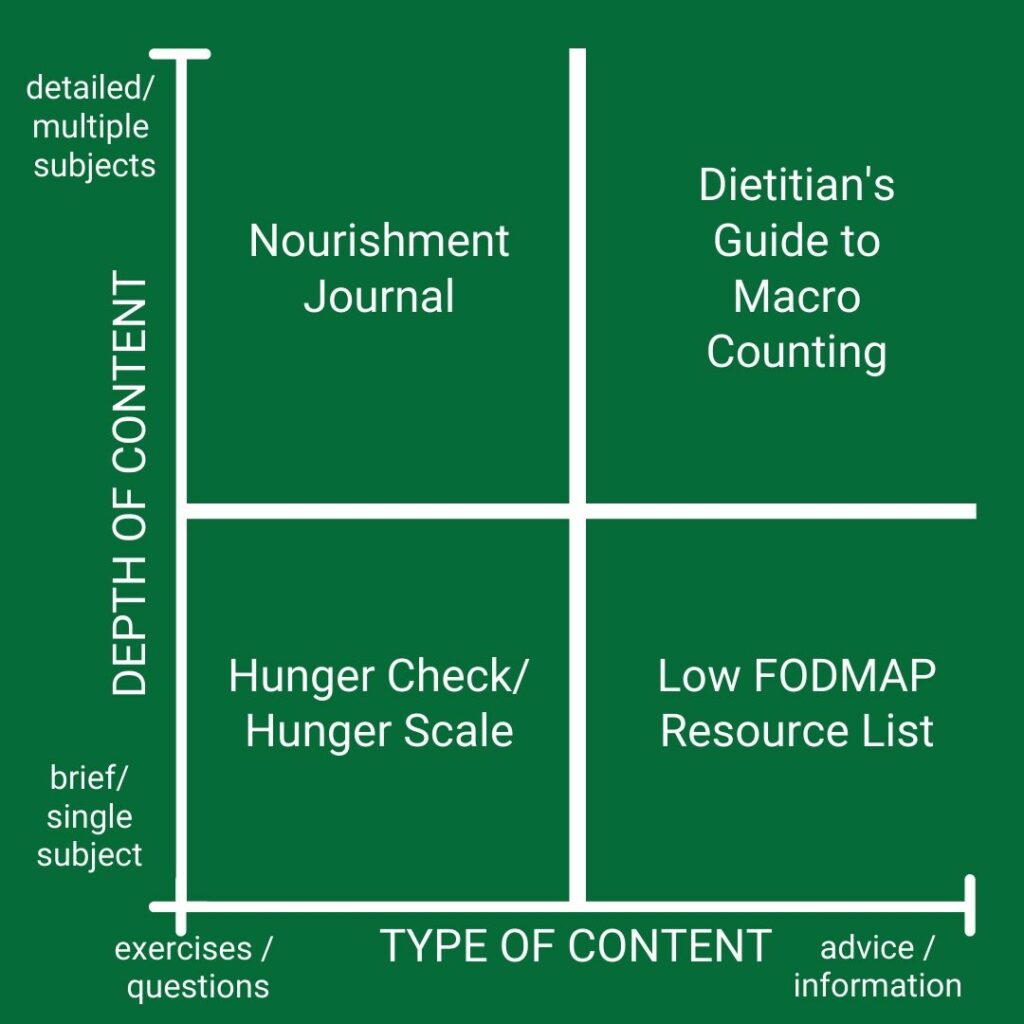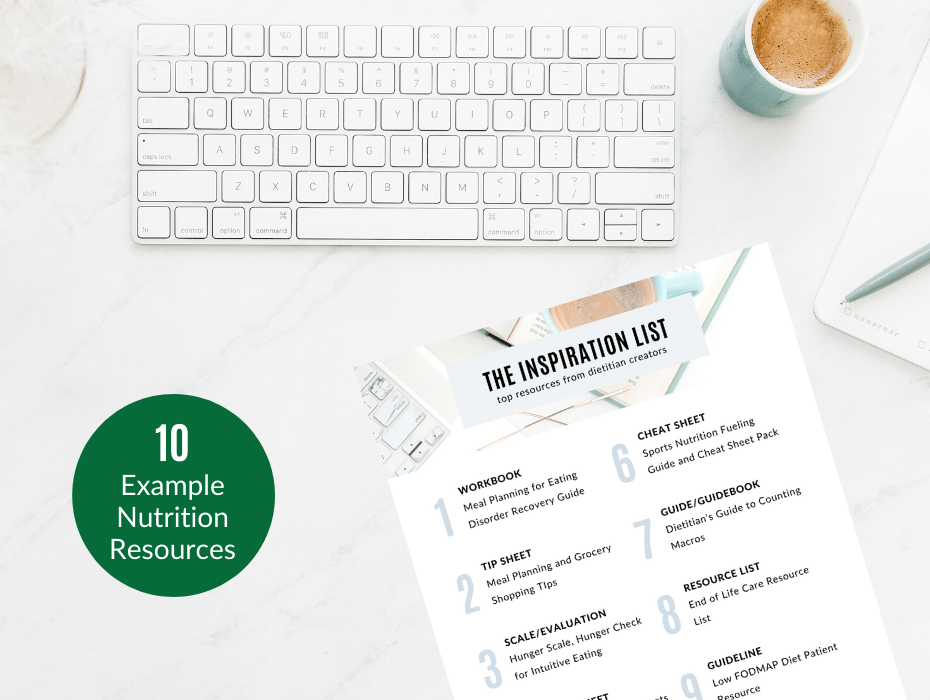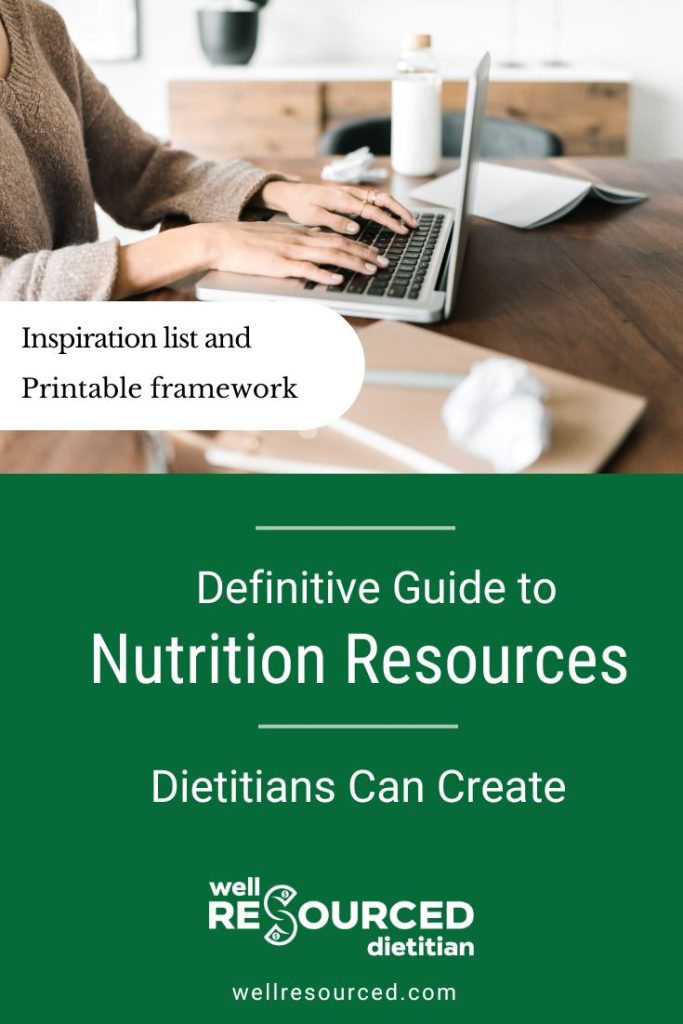Whether you’re creating a nutrition resource to sell for passive income or a free download to grow your email list, you want your final product to be a winner.
- What should I create?
- What do I call it?
- How long does it need to be?
If these are questions you’ve been asking, you’ve come to the right place. This article will provide a framework for deciding on the type of resource that is the best fit, and give examples of high performers.
What makes a great nutrition resource?
A successful resource is about more than choosing a clever title or a popular niche.
Starting with a clear idea of the type of resource you want to create will help you:
- be more efficient and focused during creation and design
- develop a strong marketing plan from the beginning
There are two key elements to consider with your nutrition resource: (1) type of content and (2) depth of content. Once you’ve clearly identified these elements, you’ll find the creation process more streamlined.
Now, let’s explore each of these elements in detail.
Be sure to grab the framework visual and save it for later reference.

1. What is the type of content?
It’s easiest to think of two distinct categories. First, advice and information and second, exercises with instructions.
Exercises with instruction: this type of content most often includes open space for reflection, questions to answer, or self-assessment/quizzes.
Advice/information: this type of content focuses on simplifying or explaining a subject/topic. It may take the form of visual such as an info graphic, chart/diagram or written text.
Neither of these content types is better nor more valuable than the other. What’s important is to distinguish the type of content your resource will include.
Nutrition resources may have attributes of both, but will typically fall towards one end of the spectrum or the other. Imagine a line between these two categories and try to place your resource idea appropriately.

Don’t worry if you’re not sure yet. That’s totally normal as you start the development process. Take some time to reflect on the objectives you want your resource to accomplish and then think about the type of content that is the best fit.

Here’s a great example that shows the difference between these two content types. You can easily see the difference between an advice/information and exercise/question resources.
Example: Exercise/questions
The “I Want to Lose Weight” Workbook – note the questions and open space for answers.
Example: Advice/information
Thyroid Support Workbook – note the well-organized lists by topic.
Did you click and review the description by the author?
When you have a clear understanding of the type of content and purpose, it is much easier to create a compelling product description that helps your product sell.
2. What is the length and depth of content?
Once you’ve decided on the type of content, the next decision is how in depth you want your resource to be.
Brief: typically 1-9 pages covering key aspects of a single subject or topic
Comprehensive: usually 10 or more pages with detailed information about a single subject or a collection of information about multiple topics.
A common trouble spot for dietitian creators is a resource that continues to grow in scope and content. It never gets completed! Starting your creation process with clarity around depth of content will help you stay focused and get to the finish line.

If you’re struggling with how extensive to make your resource, don’t worry. It’s not necessary to start with a specific number of pages in mind. Instead, choose a level of depth and focus on creating content that is in alignment.
The design and flow of your final resource will be a determining factor in the final length. Cramming too much information on one page to save space or adding extra images to add length aren’t necessary.

Here’s a great example that shows difference between a brief and detailed resource.
Example: Brief/single subject
Plant-Based Pantry Ideas for CKD – note the 2-page length and narrow focus.
Example: Detailed, multiple subjects
Body Image Bundle – note the numerous resources (50+) covering a variety of topics,
3. The nutrition resource creator’s framework
We’ve now considered two important elements for nutrition resources, depth and type of content. When combined, they form a valuable framework.

The quadrants allow for more focus on the purpose of the nutrition resource you’re creating, as well as the type of content to include.
By adding some example resource types, you can start to appreciate the clarity this framework provides.

Finally, by including specific examples of resources for each, it becomes easier to envision your own resource idea within the framework.

Want more ideas? Get the inspiration list. Download the FREE, 5-page Quick Reference.

Summary and Next Steps
Creating a nutrition resource to sell or use to grow your email list is a smart decision. However, the development process can feel daunting.
Use the nutrition content creator’s framework and quick reference guide to streamline your approach.
You will save time and increase the performance of your finished product by getting clear on the type and depth of content to include.
Looking to earn money from your resources?
Be sure to grab a copy of my FREE e-book, “Leveraging Digital Goods: More Money, More Business” with a BONUS getting started checklist. Enter your email, below!










